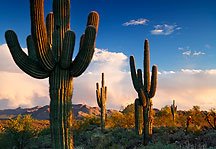 The following is part of a 6-part series examining Senator Obama's proposed energy plan that he would implement as President.
The following is part of a 6-part series examining Senator Obama's proposed energy plan that he would implement as President.To get a full overview, I suggest you scroll down to Part 1 and work your way up. Thanks for reading! S
Improving energy efficiency is the fastest, cheapest most cost-effective method to reducing greenhouse gas emissions, and it results in significant savings for our government, economy and consumers.
For example, since DuPont implemented an energy efficiency program in 1990, it has cut its energy bills by $3 billion, reduced pollution by 72 percent and increased production activities by over 30 percent.
Barack Obama will set a bold national goal of reducing the energy intensity of our economy 50% by 2030.
- Make the Federal Government the Leader in Saving Electricity: As the nation’s largest consumer of electricity, Barack Obama believes that the federal government should take the lead in reducing its energy consumption. Obama will:
- Make Federal Buildings More Efficient: Obama will ensure that all new federal buildings are zero-emissions by 2025, and to help reach that goal, he will ensure that all new federal buildings are 40 percent more efficient within the next five years. Obama will also place retrofitting existing federal buildings at a top priority, and seek to improve their efficiency by 25 percent within 5 years.
- Overhaul Federal Efficiency Codes: The current Department of Energy has missed 34 deadlines for setting updated appliance efficiency standards, which has cost American consumers millions of dollars in unrealized energy savings. Obama will overhaul this process for appliances and provide more resources to his Department of Energy so it implements regular updates for efficiency standards. He will also work with Congress to ensure that it continues to play a key role in improving our national efficiency codes.
- Use Innovative Measures to Dramatically Improve Efficiency of Buildings: Buildings account for nearly 40 percent of carbon emissions in the United States today and carbon emissions from buildings are expected to grow faster than emissions from other major parts of our economy. It is expected that 15 million new buildings will be constructed between today and 2015. Barack Obama believes that we have both an opportunity and a responsibility to make our new and existing buildings more efficient consumers of electricity.
- Set Building Efficiency Goals: Barack Obama will establish a goal of making all new buildings carbon neutral, or produce zero emissions, by 2030. He’ll also establish a national goal of improving new building efficiency by 50 percent and existing building efficiency by 25 percent over the next decade to help us meet the 2030 goal.
- Establish a Grant Program for Early Adopters: Obama will create a competitive grant program to award those states and localities that take the first steps in implementing new building codes that prioritize energy efficiency, and provide a federal match for those states with leading-edge public benefits funds that support energy efficiency retrofits of existing buildings.
- Flip Incentives to Energy Utilities: Obama will work to “flip” incentives to state and local utilities by ensuring companies get increased profits for improving energy efficiency, rather than higher energy consumption. Currently, utilities make profits when consumers purchase more energy, and when consumers purchase energy at peak times when energy prices are higher because of greater demands on the system. This decoupling of profits from increased energy usage will incentivize utilities to partner with consumers and the federal government to reduce monthly energy bills for families and businesses. Obama will provide early adopter grants and other financial assistance from the federal government to states that implement this energy efficient policy.
- Expand Federal Efficiency Grants: Obama will also expand federal grant programs to help states and localities build more efficient public buildings, including libraries, schools and police stations that adopt aggressive green building provisions like those provided by the Leadership in Energy and Environmental Design (LEED) program of the U.S. Green Buildings Council. Obama will also partner with the private sector to ensure that more companies and building contractors are aware of the short-term and long-term benefits of building “green.”
- Phase out Traditional Inefficient Light Bulbs: For over 125 years, Americans have used the same incandescent light bulb technology, which consumes much more energy for the same results as newer lighting technologies. Barack Obama supports the effort led by Senate Energy and Natural Resources Chairman Jeff Bingaman (D-NM) to update federal lighting efficiency standards to ensure that new lighting technologies are phased into the marketplace. As president, Obama will implement legislation that phases out traditional incandescent light bulbs by 2014. This measure alone will save American consumers $6 billion per year on monthly electricity bills and will save 88 billion kilowatt hours of electricity per year. By 2030, this change will result in greenhouse gas reductions of nearly 28 million tons of carbon.
- Invest in a Digital Smart Grid: Like other pieces of infrastructure, such as roads and bridges our energy grid is outdated and inefficient, resulting in $50-100 billion dollar losses to the U.S. economy each year. The 2003 East Coast blackout alone resulted in a $10 billion economic loss. Like President Eisenhower did with the interstate highway system, Barack Obama will pursue a major investment in our national utility grid to enable a tremendous increase in renewable generation and accommodate 21st century energy requirements, such as reliability, smart metering, and distributed storage. Obama will invest federal money to leverage additional state and private sector funds to help create a digitally connected power grid. Creating a smart grid will also help insulate against terrorism concerns because our grid today is virtually unprotected from terrorists. Installing a smart grid will help consumers produce electricity at home through solar panels or wind turbines, and be able to sell electricity back through the grid for other consumers, and help consumers reduce their energy use during peak hours when electricity is more expensive.
















No comments:
Post a Comment